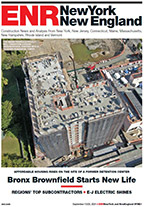Residential building, at $127.6 billion (annual rate), decreased 2% in September. The decline was due to a slower pace for multifamily housing, which fell 9% in September after witnessing gains the previous two months. Even with this downturn, the multifamily housing category in September included the start of several large apartment projects, located in Chicago ($88 million), San Francisco ($70 million), Willingboro, N.J. ($56 million), Washington, D.C. ($55 million), and Addison, Texas ($54 million).
For the first nine months of 2011, multifamily housing was up 10% in dollar terms compared to the same period a year ago, due to this behavior by major region: the South Atlantic, up 27%; the West, up 24%; the Northeast, up 10%; the South Central, down 2%; and the Midwest, down 8%.
Single-family housing in September held steady with August, as the pattern of recent months suggests that activity is stabilizing at a low volume after the declines shown earlier in 2011. On a year-to-date basis, single-family housing in dollar terms was down 5% from the same period a year ago, due to this behavior by major region: the South Atlantic, down 2%; the South Central and West, each down 5%; the Midwest, down 8%; and the Northeast, down 13%.
Nonbuilding Construction
Nonbuilding construction in September climbed 11% to $160 billion (annual rate), the third highest monthly rate for nonbuilding construction so far this year. While the highway category has generally slipped back in 2011, given the waning federal stimulus support, the month of September featured a 50% increase for highway construction. Large projects that aided the September highway total were $1.1 billion for a highway tunnel project in Seattle, plus two large highway projects in North Carolina valued at $115 million and $112 million, respectively.
Bridge construction also increased in September, rising 24%, with large bridge projects starting in Connecticut ($166 million) and New York ($109 million). The “miscellaneous” public works category, which includes pipeline and mass transit work, climbed 25% in September and was helped by the start of a $300-million carbon dioxide gas pipeline in Wyoming and a $164-million mass transit project in Colorado.
For the environmental public works categories, water supply systems grew 18% in September, but decreased contracting was reported for sewers, down 28%; and dams/water resources, down 74% (following the elevated amount in August that included $1.5 billion for work on the Olmsted Dam in Kentucky).
The electric power category had a particularly strong showing in September, advancing 52% from the previous month. Large projects that lifted the September electric utility total were the following—a $2.2-billion solar power plant in California, a $310-million natural gas-fired power plant in California, a $302-million wind farm in Kansas, a $216-million wind farm in Nevada, and a $150-million geothermal power plant in Nevada.
The 5% decline for total construction on an unadjusted basis during the first nine months of 2011 was the result of reduced contracting for each of the three major sectors. Nonresidential building dropped 9% year-to-date, as a 16% slide for institutional building outweighed a 3% gain for commercial building and a 27% increase for manufacturing building.
Residential building was down 3% year to date, the result of the 5% slide for single-family housing combined with the 10% gain for multifamily housing. Nonbuilding construction fell 2% year-to-date, with public works down 18% while electric utilities soared 100%.
By geography, total construction starts performed as follows in the first nine months of 2011 relative to last year: the West, up 8%; the South Atlantic, down 4%; the South Central, down 6%; the Midwest, down 11%; and the Northeast, down 14%.



